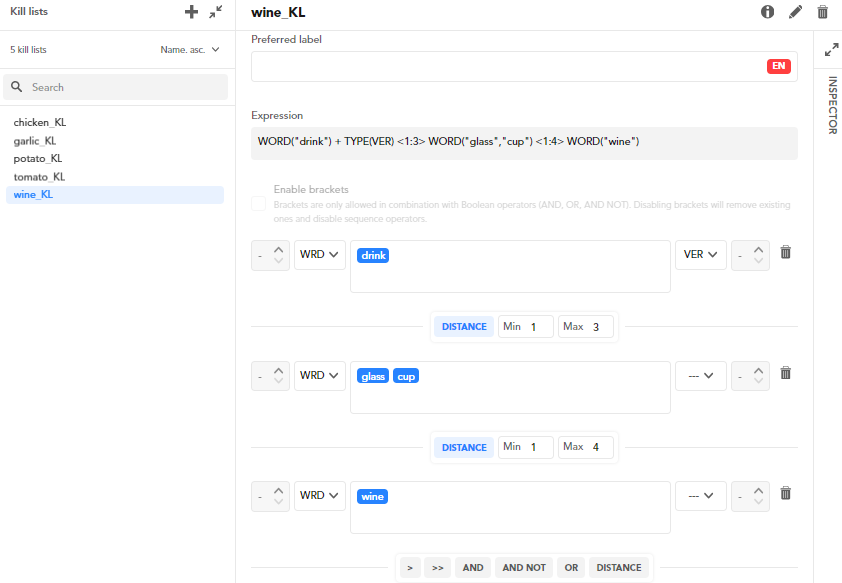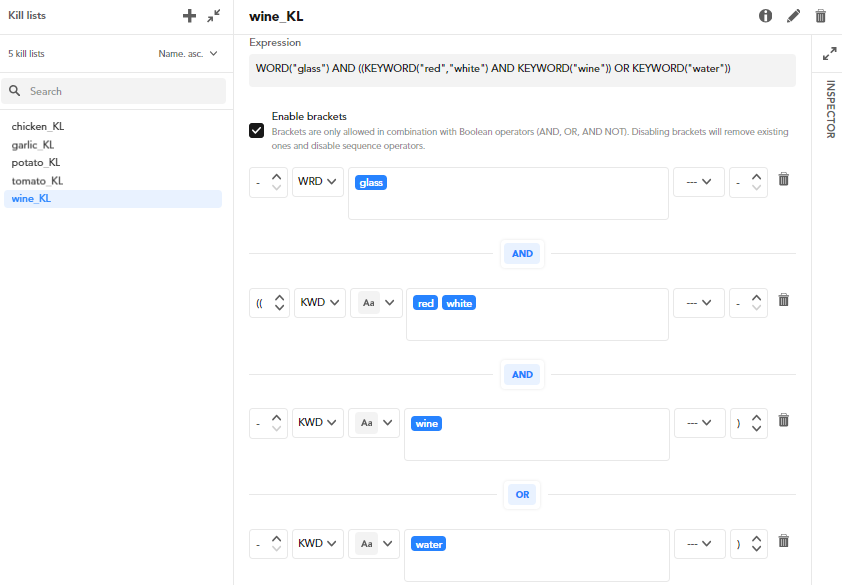Kill lists
Overview
A kill list, like a rule concept list, is a condition related to the text of a document.
If a concept of the taxonomy is marked for extraction and a mention of it is found in a text, it is extracted only if no kill list associated to it is triggered by the same text. A kill list, therefore, can cancel extractions.
Like rule concept lists, a kill list can cover one or more project languages.
All the kill lists can be managed in the Kill lists tab of the Resources panel, which is located in the Resources tab of the project dashboard.
Info
A kill list is not necessarily and always connected one-to-one with a concept: there can be moments in which a list is not associated with concepts yet/anymore, the same list can be associated with different concepts and a concept can have multiple lists associated with it (many-to-many relationships between kill lists and concepts).
The kill lists associated with a concept can be also managed in the Kill lists tab of the Edit concept panel.
To open the Kill lists tab of the Resources panel:
- Select the Resources tab on the main dashboard toolbar: the Resource panel is displayed.
- If the concept tree is displayed, turn it off by selecting Toggle custom elements
 on the toolbar of the Resources panel. The concept tree is replaced by a list of tabs.
on the toolbar of the Resources panel. The concept tree is replaced by a list of tabs. - Select the Kill lists tab in the Resources panel.

Create
To create a new kill list:
- If there are no lists already, select Create kill list in the center of the page.
- If at least one list is already defined, select Create kill list
 on the right of the header of the Kill lists panel.
on the right of the header of the Kill lists panel.
The Create kill list dialog appears. Enter the name of the list and select Save.
The new list is automatically selected and its details are shown in the right panel.
Define the list
To edit a kill list, select it: its components are displayed on the right panel.
A kill list can consist of a preferred label, an expression or both, for every project language.
The preferred label is interpreted as a literal that must be matched in the text.
The expression is constructed with operands and operators of a special language described in the reference section.
If both the preferred label and the expression are defined, they can be considered as implicitly combined with an OR Boolean operator, so the kill lists is triggered when one or both parts are matched by the document's text.
Warning
The preferred label of a kill list, which is optional, has nothing to do with the preferred label of a concept. It is a characteristic of the kill list and a quick way to define it when you just need to match literal text.
Also, as noted above, a kill list does not necessarily have a relationship with a particular concept, there is a many-to-many relationship between kill lists and concepts.
In the definition panel there are composition controls that allow you to build the expression interactively, while the gradually constructed expression is visible in the Expression field.
To define the kill list portion for a particular language, first select the language tab. In the case of a single project language there are no tabs.
To set an operand, choose its type from the operand dropdown list. Depending on your choice, the controls on the right change according to this rule:
| Operand type | Second field | Third field | Fourth field |
|---|---|---|---|
| Pattern | Case sensitivity dropdown list | Value | Grammar/entity type dropdown list |
| Keyword | Case sensitivity dropdown list | Value | Grammar/entity type dropdown list |
| Word | Value | Grammar/entity type dropdown list | N/A |
| Stem | Value | Grammar/entity type dropdown list | N/A |
| Type | Value (Grammar/entity type dropdown list) | N/A | N/A |
In the table above, "Value" is the value of the operand, therefore:
- A regular expression in case of Pattern
- A literal in case of Keyword
- A base form (dictionary entry) in case of Word
- A flexed or a declined form of a dictionary entry in case of Stem
- A grammatical or entity type in case of Type.
If you selected Pattern or Keyword, select the case option in the dropdown list beside the operand list. You can select if your match has to be case sensitive or insensitive.
All operands except for Type allow you to specify more operand values:
- Type a value and press
Enter. - Repeat step 1 as many times as needed.
All operands except for Type allow you to optionally specify the grammar or the entity type. Select an option from the dropdown menu on the right of the value. More information about grammar and entity in the dedicated page.
Next, you can choose the operator that links the operand to any subsequent one. The operator is chosen from the button panel under the operand and once the choice has been made:
- The button panel is replaced by the chosen operator.
- The visual builder of the new operand appears below the operator.
To go back to the operator choice, select the operator name: the visual builder of the new operand disappears.
Note
The DISTANCE operator has two parameters, Min and Max, which represent the minimum and maximum distance between the text tokens corresponding to the two operands.
The expression is automatically saved after each change.
If at least two operands are defined—or being defined—, to delete one, select the trash bin icon  to the right of the operand fields.
to the right of the operand fields.
Manage brackets
For a better management of multiple operands in combination with boolean operators, check Enable brackets. The use of brackets will automatically disable the DISTANCE operator and the positional operators. To add and remove left and right brackets, select the up  and down
and down  arrows from the leftmost and rightmost dropdown lists of an operand.
arrows from the leftmost and rightmost dropdown lists of an operand.

Note
When adding brackets, Platform can automatically remove unnecessary ones and add new ones that do not change the expression meaning.
If you uncheck Enable brackets after building an expression with parentheses, a dialog will warn you about the automatic removal of already inserted brackets.
Filter and sort
You can use the controls in the Kill lists panel to filter and sort lists.
To filter kill lists, type something in the search box: only the lists whose name contains what you typed will be shown, the match is case sensitive. Select the X icon  or delete what you have typed to cancel the filter.
or delete what you have typed to cancel the filter.
To change the sort order, use the dropdown menu above the list.
Manage target concepts
By selecting and deselecting Show more information  on the toolbar of the right panel, you toggle between the definition of the kill list and the list of concepts to which it is associated, the target concepts.
on the toolbar of the right panel, you toggle between the definition of the kill list and the list of concepts to which it is associated, the target concepts.
To add a target concept, that is to associate the kill list with a concept:
- Select Add target concept
 in the center of the panel or to the right of the Target concepts label: the Add a target concept dialog appears.
in the center of the panel or to the right of the Target concepts label: the Add a target concept dialog appears. - Type at least two characters in the Target concept field. All concepts with a main label that contains what you typed will be listed in the dropdown menu. The match between what you type and the label of the concepts is insensitive cases. Choose the concept from the list.
- Select Add.
To delete a target concept, that is to disassociate the kill list from a concept, select the X icon  on the right of the concept row.
on the right of the concept row.
You can also associate and disassociate a kill list with a concept by operating in the Kill lists tab of the Edit concept panel.
Change the name
To change the name of a kill list, select Edit kill list  to the right of the list name. The Edit kill list name dialog appears. Edit the list name and select Save to commit the change.
to the right of the list name. The Edit kill list name dialog appears. Edit the list name and select Save to commit the change.
Inspect
The INSPECTOR panel, on the right edge of the page, contains two tabs:
- Guide: a guide to operators
- Inspector: contextual information about the item selected in the adjacent panel, possibly with navigation shortcuts
To toggle the INSPECTOR panel select the expand  and collapse
and collapse  icons at the top of the panel.
icons at the top of the panel.
The concepts to which a kill list is possibly associated are called target concepts. To manage other target concepts and related kill lists in the INSPECTOR panel, Inspector tab:
- Select one of the target concepts below Target concepts. Various information will appear including kill lists cancelling the extraction of the concept in focus.
- Select Edit concept to see the other concept in focus.
Or:
- Select a kill list under Killed by to put the other kill list in focus in the INSPECTOR panel.
Or:
- Select Back to undo the operation.
Delete
To delete a kill list, select Delete kill list  on the toolbar of the right panel.
on the toolbar of the right panel.